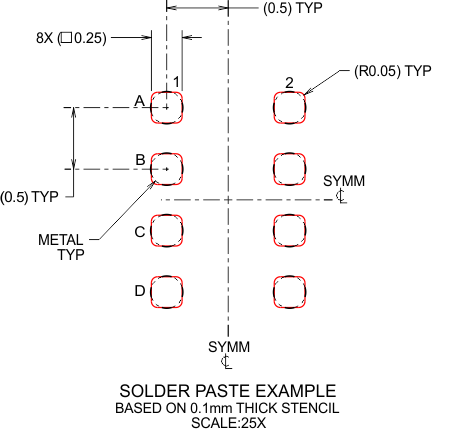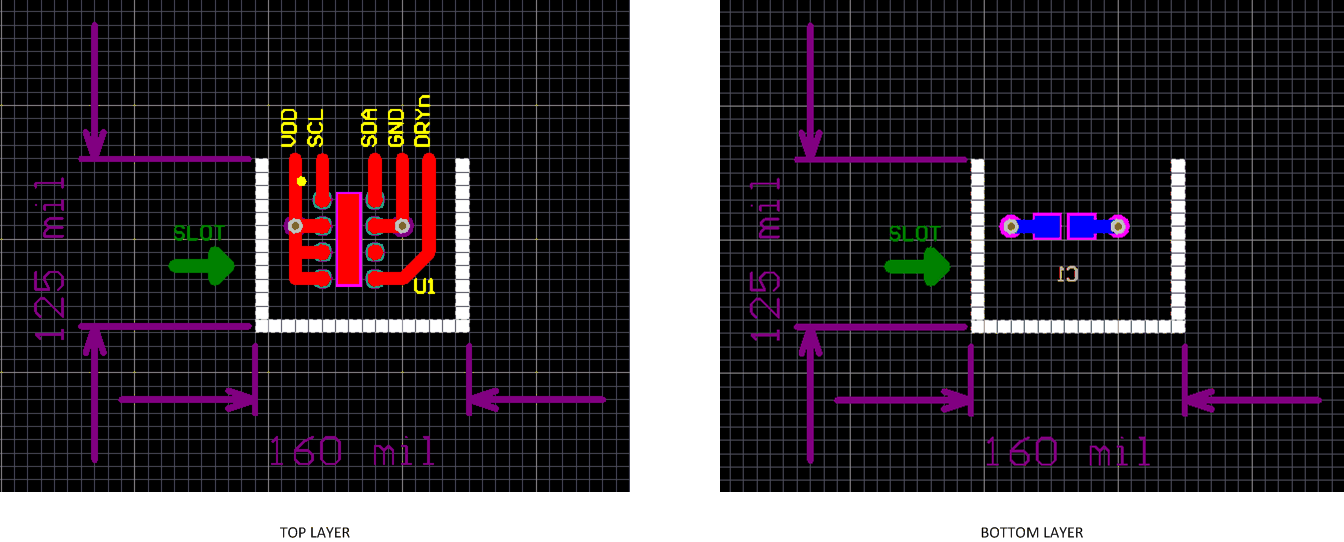SNAS685A May 2016 – August 2016 HDC1010
PRODUCTION DATA.
- 1 Features
- 2 Applications
- 3 Description
- 4 Typical Application
- 5 Revision History
- 6 Pin Configuration and Functions
- 7 Specifications
- 8 Detailed Description
- 9 Application and Implementation
- 10Power Supply Recommendations
- 11Layout
- 12Device and Documentation Support
- 13Mechanical, Packaging, and Orderable Information
Package Options
Mechanical Data (Package|Pins)
- YPA|8
Thermal pad, mechanical data (Package|Pins)
Orderable Information
11 Layout
11.1 Layout Guidelines
The Relative Humidity sensor element is located on the bottom side of the package. It is positioned between the two rows of bumps
It is recommended to not route any traces below the sensor element. Moreover the external components, such as pull-up resistors and bypass capacitors need to be placed next to the 2 rows of bumps or on the bottom side of the PCB in order to guarantee a good air flow.
It is recommended to isolate the sensor from the rest of the PCB by eliminating copper layers below the device (GND, VDD) and creating a slot into the PCB around the sensor to enhance thermal isolation.
11.1.1 Surface Mount
Two types of PCB land patterns are used for surface mount packages:
- Non-solder mask defined (NSMD)
- Solder mask defined (SMD)
Pros and cons of NSMD and SMD:
- The NSMD configuration is preferred due to its tighter control of the copper etch process and a reduction in the stress concentration points on the PCB side compared to SMD configuration.
- A copper layer thickness of less than 1 oz. is recommended to achieve higher solder joint stand-off. A 1 oz. (30 micron) or greater copper thickness causes a lower effective solder joint stand-off, which may compromise solder joint reliability.
- For the NSMD pad geometry, the trace width at the connection to the land pad should not exceed 2/3 of the pad diameter.
 Figure 18. Solder Mask
Figure 18. Solder Mask
11.1.2 Stencil Printing Process
- Use laser cutting followed by electro-polishing for stencil fabrication
- If possible, offset apertures from land pads to maximize separation and minimize possibility of bridging for DSBGA packages
- Use Type 3 (25 to 45 micron particle size range) or finer solder paste for printing
 Figure 19. Solder Paste
Figure 19. Solder Paste
11.2 Layout Example
The only component next to the device is the supply bypass capacitor. Since the relative humidity is dependent on the temperature, the HDC1010 should be positioned away from hot points present on the board such as battery, display or micro-controller. Slots around the device can be used to reduce the thermal mass, for a quicker response to environmental changes.
 Figure 20. Layout
Figure 20. Layout